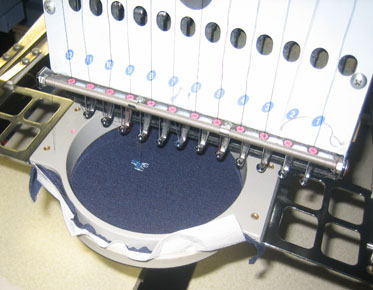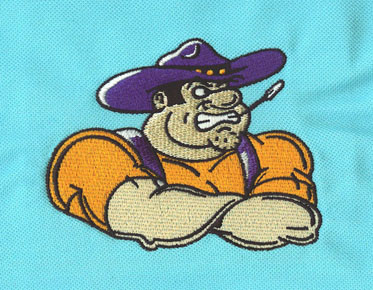Knowledge from Eagle digitizing: How to Use Appliques in Commercial Embroidery
Appliques give commercial embroidery extra texture, keeping it clean and bright. They are easy to create and are a useful way to add more value to a wide range of clothing and products. The following content also has some reference value for Eagledigitizing.
Applique is an indispensable design for business embroidery. It is widely used in the clothing of children, cheer, athletic teams and so on. Actually, all of your customers will benefit from the addition of appliques to your line of products. This is a great way to add depth, color and texture to commercial embroidery.
Applique in the embroidery business add value to everything from novelty designs and corporate apparel to wearable art and uniforms. They are easy to make, need only contour stitching, and are high profit add ons, making commercial embroidery look clean, clear and beautiful.
Prepare clothing for appliques:
Prepare a dress to add appliques the same as commercial embroidery. The second layer of fabric on the substrate does not mean that you can forget the proper backing or stability.
The medium to lightweight CutAway backing is ideal for matching with stretch fabrics such as fleece sweatshirts or T-shirts. The lightweight tear backing is suitable for knitted fabrics such as denim shirts, jeans and jackets, canvas handbags and computer cases.
Prepare applique fabric:
Fabrics used for commercial embroidery appliques must have minimal wear and shrinkage. Most pre fabricated appliques fabrics have been treated and ready for cutting. It doesn't need more treatment.
Other fabrics may require additional preparation to use for appliques. First, wash and dry the fabric for washable fabrics containing more than 30% cotton. This will pre shrink the fabric to remove any excess dye or starch. (If in doubt, please clean it!
In general, fabrics containing synthetic fibers (polyester, acrylic or nylon) do not shrink and therefore do not require pre washing. Silk, wool, suede and leather as well as other dry cleanable fabrics are also suitable for applique without pre shrinking. Remember, if you make appliques from dry cleanable fabrics, you need to dry clean the entire garment
After pre shrinking the appliques fabric, use double-sided heat sensitive stabilizer on the back of the material. This helps to bind the fibers and prevent abrasion (especially when using serrated finishing stitch). It not only stabilizes the fabric, but also makes it easier to cut. The backing helps the appliques stick to the garment permanently.
Use a hot press to connect the double-sided stabilizer to the fabric, with the right side of the fabric down and the paper backing. Keep the paper complete, you can directly trace the outline of the appliques on the paper; This makes it suitable for manual cutting, or sending to commercial cutting machines.
The back glue also makes the appliques easy to use and prevents shrinking and blistering after washing.
How to sew commercial embroidery appliques:
Choose your appliques by hand pre cutting the shape or buying a ready-made pattern from a commercial cutter.
Prepare the substrate as you would any other commercial embroidery. Choose the right backing for the fabric used: TearAway is used for durable fabrics, denim and knits; Suitable for more stretch fabrics such as T-shirts and fleece. Cover the backing with clothes.
The clothes are hooped and marked, and then the hoops are put into the commercial embroidery machine. Download the appliques design to your system from your Stitch ERA Liberty or other embroidery design software.
Always check the alignment of the design to the garment. If you rotate the garment to facilitate embroidery stitching, be sure to adjust the design as well.
Contour stitch is sewn in a color similar to the garment fabric. You can set the embroidery machine to stop after sewing contour stitches to allow placement of appliques materials. When digitizing with Stitch ERA Liberty, you can include automatic pauses in your design.
Place the pre cut appliques in the stitching profile (it should fit perfectly). Use Sprayway's # 66 spray adhesive to fix it in place, or if you use a double-sided backing, use a appliques iron to set it. Make sure that the appliques does not move during sewing.
Restart your commercial embroidery machine and use your finishing stitch to secure the decal.
Repeat this process if the embroidery project uses multi-layer appliques. Besides, you will be finished!
Remove the clothes from the machine and unfasten the fabric. Press the design with a hot press or hand iron. This will complete the adhesion of the appliques to the garment and avoid problems such as "blistering" or shrinkage after washing. If you want to add appliques to the fabric, such as corduroy or suede, turn the garment over and heat press the back of the design. This will prevent the pile from flattening.
Pricing appliques:
Appliques are labor intensive, so the price
is higher than most other commercial embroidery. The advantage is that appliques
can replace thousands of stitches, saving sewing time. Yes, the embroidery
machine stopped, slowing down the production. However, in addition to the
higher value of finished clothing, the saved stitch can also make up for
downtime.



